Marmon-Herrington. Everything you wanted to know
If you dive a little bit history American tank building, sooner or later you will come across a marvelous and iridescent name - “Marmont-Herrington”. Not to say that it is very melodic, but intriguing. Particularly intriguing in that Tanks they did, and armored cars, and which, when and how much - is unclear. Well, you think, then I’ll figure it out somehow ... But until I put it off? Here it is, this "later." So, let me introduce you to the story of the American Marmont family and design engineer Arthur Herrington.
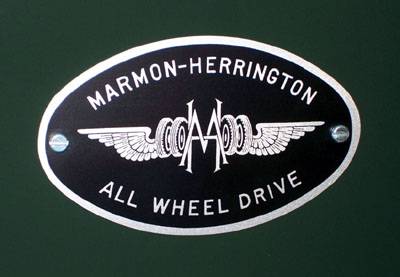
Nordyke, Ham & Company
It all began in 1851 in Richmond, Indiana, where Ellis Nordike first himself, and then, together with his son Addison, began to manufacture flour milling equipment for mills. The plant was tiny, the volumes were small, but the matter was arguing. Already by 1858 Nordyke was able to produce a complete set of turnkey equipment, the company was renamed E. & AH Nordyke. Around the same years, a young boy Daniel Marmont was spinning at the plant, spending his childhood with interest, so to speak. Having matured and graduated from Earlham College, Daniel returned in 1866 with a business proposal to buy out part of the business. The Nordics agreed. The "kid" Marmont was only 22 years old at the time.
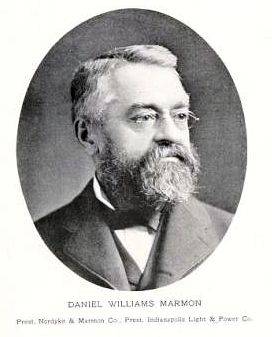
Nordyke, Marmon & Company 1866-1926
So began to be called the newly formed concern. Production expands, volumes grow and, by 1870, Nordayki and Marmont are becoming the leading manufacturers of milling equipment in the United States. In 1875, the company relocates to Indianapolis, as land and labor are cheaper there, which is better for business and provides more opportunities for expansion. The idyll continues right up to the 1926 year, when the firm (only that part of which is responsible for the mills) is completely bought out by the concern Allis-Chalmers, and the history of the mills ends there. Daniel Marmon himself died in the 1909 year. But...
However, Mr. Daniel had two sons: the eldest Walter and the younger Howard. At the turn of the century, both of them were actively involved in the family business. And if the senior managerial affairs and intercepted the reins after the death of his father, the younger went through the path of engineering. After graduating from the University of California at Berkeley with a degree in Mechanical Engineering, Howard, at the age of just 23, gets the position of chief engineer of the company. And not for Dad's position, but for his light head. Mills business, of course, is profitable and the position is serious, but youth is youth.
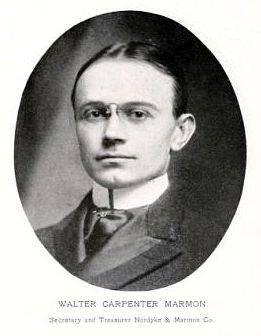
The son of a rich father, and he is quite a respectable young man, acquires a personal car. The car, of course, is not for the middle class - a luxury car, in which the talented engineer was very disappointed. Well, it would be okay just an engineer, and then an engineer, who has three factories at hand, where he is in charge ... Howard just picked up and started making his own cars from 1902 onwards.
Nordyke, Marmon & Company (automotive division) 1902-1926
Thus was born a new direction of activity. Immediately taking off the bat, the young guy makes the first car with a two-cylinder V-engine with the active use of aluminum parts and a rather progressive design.
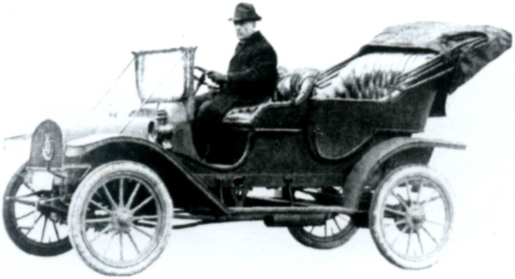
First
After running ideas on the firstborn, in 1904, Howard already makes a four-cylinder (20 hp) Marmon Model A air-cooled car and the world's first system of forced lubrication under pressure. In the automotive history appears oil pump. Here we are talking about a series, made and sold 6 copies.
Then a similar Model B with a slightly improved engine (24 hp) appears on the light. These have already been made 25 pieces and each sold for 2500 dollars. Well, gone, gone. You can still talk a lot about these wonderful cars, but “Military Review” is not “Driving.” I will note only the most prominent success of the family in the automotive field.
So, it was the racing modification of the car Marmon 32, nicknamed Wasp, won in the 1911 year, the first in the history of America Indianapolis 500 race. It was first built according to the "monocoque" scheme, and the first time used rear-view mirrors.
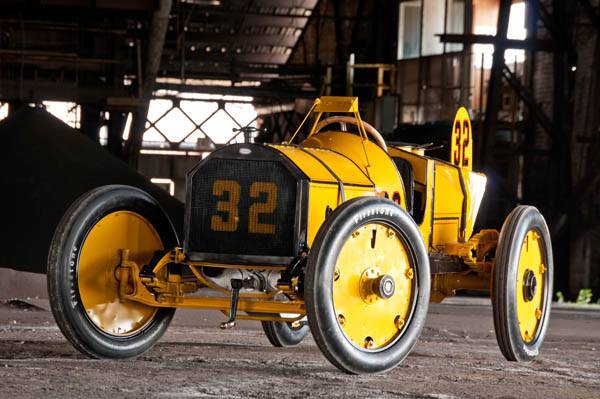
Wasp
In 1916, Cadillac's record for traveling across the US "from coast to coast" was broken at Marmon 34. Beaten seriously, at 41 an hour, sales soared.
1917, received a contract for the manufacture of 5 thousand aviation Liberty L-12 engines (jointly developed by Packard and Hall-Scott Motor Co.).
Howard in 1927 started developing the first V-16 engine in the world, but due to financial difficulties, it was possible to launch the Marmon Sixteen model only for 1931. Chrysler and Peerless had already produced their V-16, which, by the way, were engineers all the same Marmont.
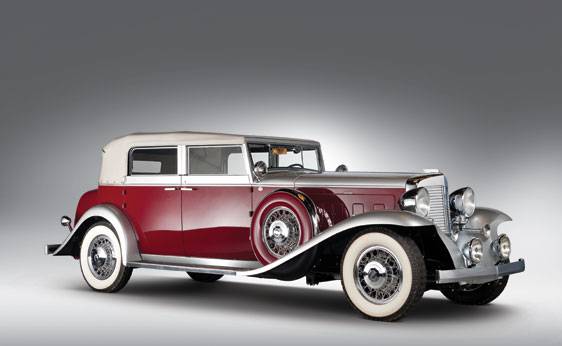
The pinnacle of creativity - Marmon Sixteen
Aluminum, aluminum everywhere and everywhere, they became the ancestors of the mass introduction of light metal in the automotive industry.
Marmon Motor Car Co. 1926-1933
The First World War ended, where Howard volunteered and managed to reach the rank of Air Force Lieutenant Colonel. Europe has quietly faded away, and in the meantime the American economy has been shaken. To fix things, Walter, his elder brother, had to sell the company's milling division and reorganize the car factory under a new name. The younger one plunged into technical reorganization and preparation for the release of new models.
Largely thanks to the successful Marmon Little and Roosvelt (the first car in the world equipped with a row eight, with a price of less than 1000 dollars), the office remained afloat and began to slowly increase, but then the Great Depression struck. Over Marmonas again threatened poverty. In 1933, the production of luxury cars finally stopped, giving over all years of production to Americans more than 250 thousands of cars.
The Great Depression is not a joke, it was hard, and the Marmon brothers were desperately looking for a way out. Let's take a closer look at what happened. During the depression, the demand for expensive cars dropped significantly. Large corporations simply increased the production of cheap equipment to the detriment of top models. Marmonas had no such opportunity. Rather, they had relatively cheap cars, but in conditions where the buyer counts every penny, it’s no longer up to the “prestige of the brand”, but to compete in price with monsters like Ford ... Well, in short, the amba. Since it does not work with the roads, the brothers turned their eyes towards the off-road technology, and in those years, I must say, the four-wheel drive was not honored, was little used, little was produced, but the competition was significantly less. Mr. Arthur William Sidney Herrington turned up the way ...
Arthur William Sidney Herrington (1891-1970)
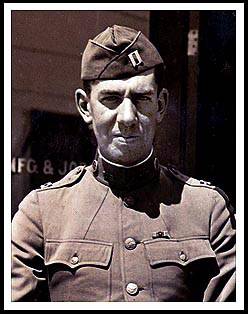
He was born in 1891 in England and at the age of 5 came to the United States, where he grew up, learned, worked for Harley-Davidson. From the beginning of World War I served in the army somewhere up to the 1927 year and rose to the captain. He resigned from promotion to major. A colonel has never been, this is a respectful nickname, which he received while working as chief engineer of the motor transport department of the US military. Working as a military engineer, has shown considerable interest in the standardization of trucks and the development of new four-wheel drive chassis. After leaving the army, he works closely with Coleman and even works for them since 1928, the general manager of the Eastern Branch.
Coleman C-25 (4х4). It is Arthur Herrington - the head of the selection committee for this truck. The car was brought to mind under his direct supervision, so it is considered one of the first Herrington models.
QMC. Serving in the US Army Quartermaster Corps (QMC), he is actively involved in the development of technology and patents for the light TTL 4x4 on the 40-strong Liberty chassis (well, they love that they all have Liberty) drive system of driving and steering wheels with a solid bridge and ball joints - Rzeppa. QMC - independently produce a whole line (more than 60) of various types of cargo vehicles, again not without the help of Mr. Herrington.
Marmon-Herrington Company Inc. 1931-1963
Geniuses should not languish in obscurity, and talent should not be wasted. In 30, Herrington thinks about an independent career outside the military department, and then Marmon, gurgling out with outgoing air, twitches by the way. Thus was born the new concern - Marmon-Herrington. Which immediately receives an order for the manufacture of 33-x aircraft tankers. And indeed, Arthur is the head of the trucks, Howard is an aviation lieutenant colonel in the reserve ... Bamts is the aircraft trucks. But the company almost never worked before this kind of technology. Almost, because I was based on the Marmon 34 small delivery truck.
The basis of Arthur takes his work from the QMC. The tanker was a success, and things seemed to start to get going. In the first half of the 30-x company produces a series of four-wheel drive truck TN series for various purposes. The newly-minted office successfully mastered a new technique for itself, expanded the line, and just at that period began to make wedges and armored cars. In the meantime, the government has prepared another “trick” in the form of a ban for QMC to engage in the development and production of equipment, leaving only standardization. Ford, GMC and Chrysler are immediately wedged into the niche. By 1935, government orders dried up, as military modifications of Ford trucks were cheaper. Marmont were again on the edge, but here the exit was found. Fords did not produce all-wheel drive versions, so Marmon-Herrington, having come to a general agreement, took up the re-equipment of Ford trucks, practically ceasing to produce its own models. What is important is that the converted machinery was sold in the country through the Ford dealer network. First it allowed to expand the model range, and Marmonas provided unlimited opportunities for marketing their products. In total, for 1940, the company offered about 70 all-wheel drive models and their modifications based on Ford cars.
Not to say that things went very well, but still went. Rescued by foreign customers, including Iran, the South African Union, the United Kingdom and even the USSR.
After the war, Ford quietly refuses to cooperate with a long-time partner and Marmon has to survive on "what is necessary." Even trolleybuses and a lot of different specialized vehicles based on trucks appear in the production line.
In 1963, the company is divided into Marmon and Marmon-Herrington, both safely exist to this day. The first deals with everything in a row, and the second continues to supply drive axles and transmissions, including such ancient truck builders as Oshkosh.
The most interesting models
If you write about all their technology, the book will turn out. Let's try to narrow the circle to the most interesting models produced under the label Marmon-Herrington.
HH6-COE4
Semi-double-axle all-wheel drive truck supplied to the USSR under the Lend-Lease, where it was used as a chassis for the "Katyush"
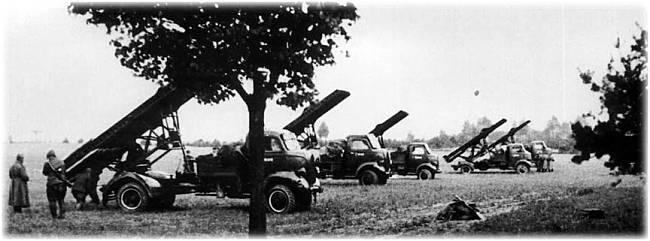
Designed specifically for action in the Sahara Desert. With a single rear tire and sloped cab roof. Equipped with a reinforced cooling system. It was delivered to Britain (and not only this model) at the beginning of the war, later cheaper Chevrolet and Dodge all-wheel drive appeared. Workhorse African theater.
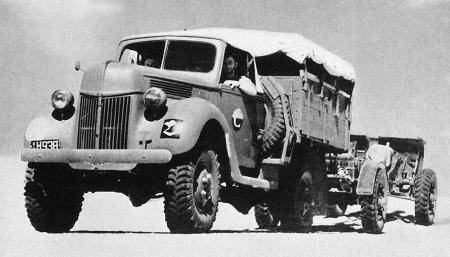
Three-axle and two-axle truck tractors are notable for the fact that they were used by Nairn for organizing Damascus-Baghdad transportation. This big story of a small transport revolution is a separate and very interesting topic. Both trucks were equipped with diesel engines (a rarity for the USA in the 1933 year) Hercules horsepower 175 hp.
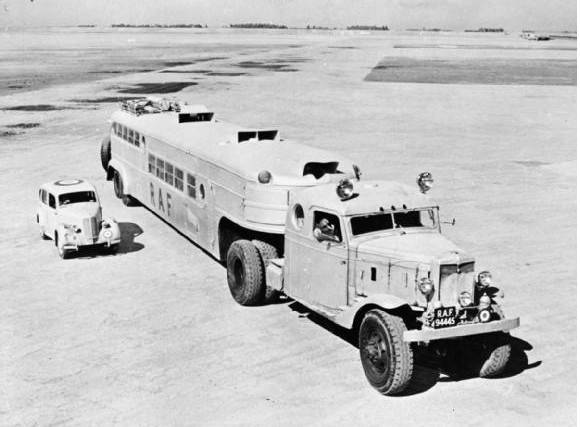
Great-grandfather Jeep. All-wheel drive car based on the Ford monochrome chassis. You can call the first "parquet" SUV. Although, of course, on the frame, then everything was on the frame.
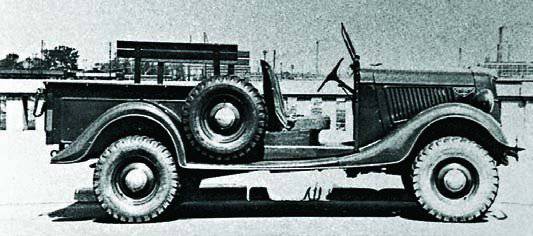
Half-tracked truck based on the Ford lorry. Another experiment of the company. Everything is clear with the front axle, but the rear tracked part was weighted.
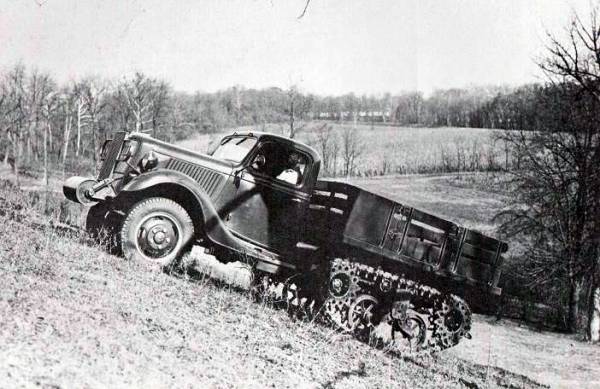
In the model Т9Е1, the rollers are made more softly, and the caterpillar is rubber-metal. The military liked it, but the one and a half ton chassis was considered too light and irrational for this type of propulsion unit. But the Canadian gunners ate and asked for supplements, that is, they used.
Rhino
Very interesting floating all-terrain vehicle, designed by Ellie Ahnides. 14 years passed from idea to implementation. The company Marmon Herrington did not directly participate in the development, but it implemented the project in the metal, so in fact it is Marmont. A strange-looking tadpole amphibian was able to accelerate to 70 km / h, powered by a strong Ford’s (well, what else) engine and weighed about 110 tons. It did not fall on board even when tilted in 4 degrees, and used a water cannon to move through the water. Total built two prototypes, one of which has been preserved to our days. The idea has not received further development.
TH310 ALF-1
In 1934-35, an order was received from Persia (Iran) for a batch of TN300-4 multipurpose chassis and staff vehicles and armored vehicles built on their basis. 310 is this armored car. There is little data about him and they are scattered. It is known that this machine was tested at the Aberdeen Proving Ground, but did not pass them, but the Persian buyers liked it. Initially, tower armament was supposed to consist of 37-mm cannon and machine guns, but in the export version they planned to replace the tower with the production of the Bofors company. Bulletproof armor, crew of a man 3, engine Hercules 115 hp The test car left and its further fate is unknown, as well as the exact amount produced is unknown. On one Polish site there is a photo with as many as 11 units, so if this is not a photo montage, of course, there is some series. This is perhaps the first specialized combat vehicle of the company.
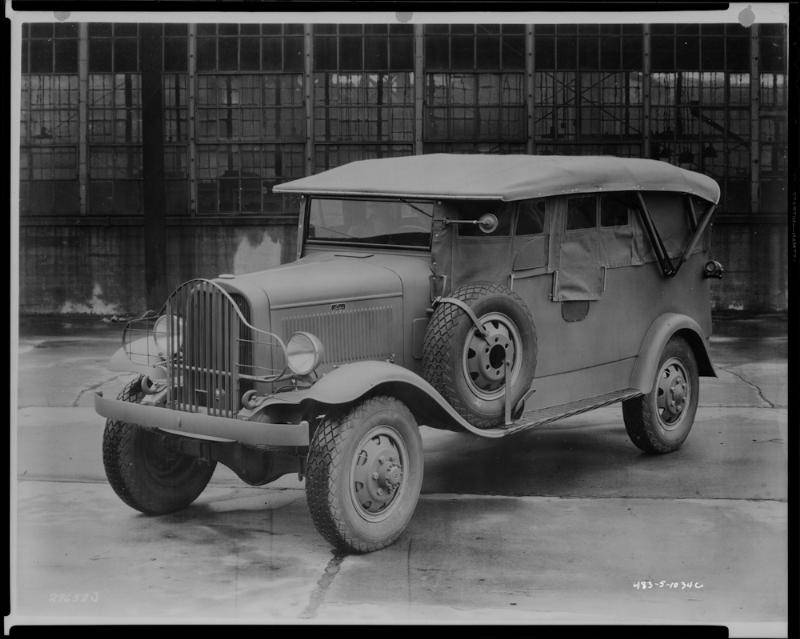
TH300-4
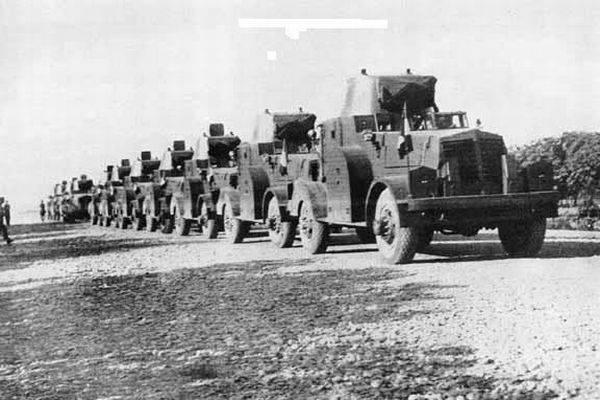
Alf
Originally developed in 1932 by FWD Auto Company for the next military competition, an armored car. The machine turned out to be curious with its advanced layout, all-wheel drive, turret armament (1 0.50 and 1 0.30 machine guns), as well as a 0.30 machine gun of caliber in the front hull plate, and appearance. From January to July, she was tested at the Aberdeen Proving Ground. Despite the successful layout, the armored car was pursued by technical failures. The first “work on the bugs” was assigned to Marmon-Herrington, from here Т11Е1 - them, and now Т11Е2 - again FWDshny. Such is the confusion, although it is not surprising for US armor. A total of 6 copies were made. In the Russian-language resources about FWD not a word, it is believed that this is a purely Marmonian model.
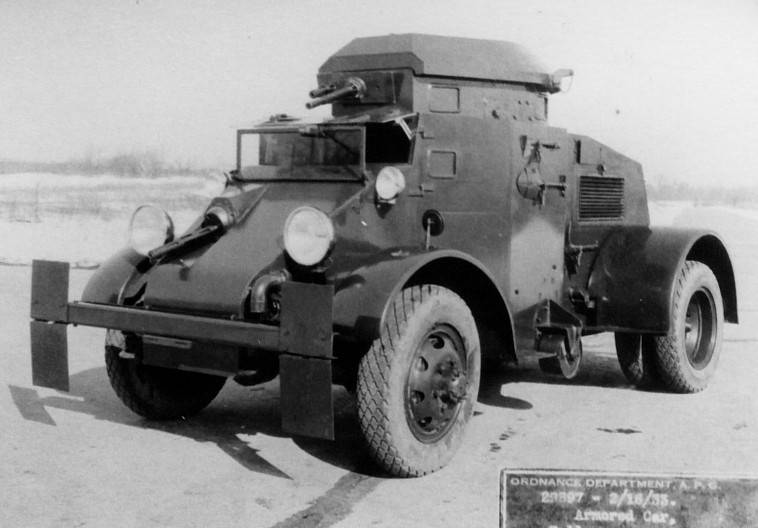
Reconnaissance armored car, developed in 1935 year. A few were sold to Iran, China and Venezuela. Naturally tested in the Eamerican army. In principle, like. The army team re-indexed it in T13 and ordered 38 machines, made in non-iron steel for training the National Guard.
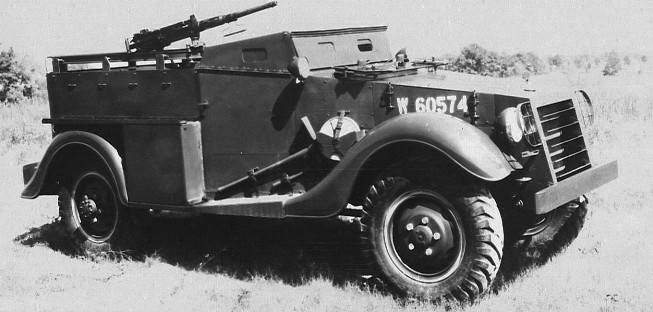
Very mysterious half-track model. Present on the company's brochure, the network has a couple of pictures, but the information is, in fact, zero. It is interesting that they installed a tower on the car, which was later rearranged to M22 Locust, which is nee T9. Marking is probably erroneous.
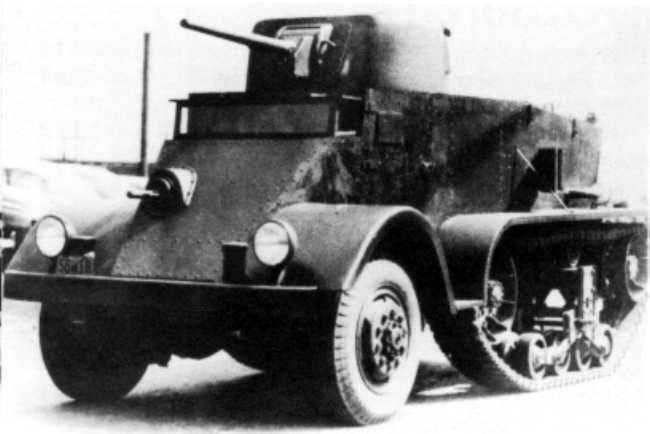
Manipooh caterpillar tractors like Vickers Gun Carrier. Designed for towing light guns, and of all other lightweight. Equipped with Ford engine V8. TBS45. Lit on the company's brochure 1944 of the year. There are data on 330 ordered cars. And the thirty-threes ordered the Netherlands in the amount of 285 pieces. They fought in Java.
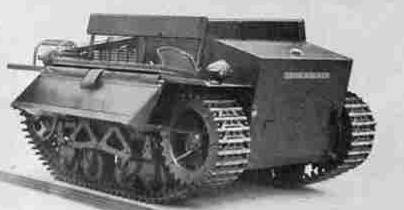
What on the basis of the monotonous Ford chassis did not come up! So with this car. At the end of the 30, Belgium ordered 47-mm anti-tank guns for its army. Marmonas undertook and built quite a good armored tug for their time. 68 units built profits in exactly the German invasion and almost complete and intact composition inherited by the Germans. The Teutonic genius also got used to the machine, but unification was such a unification ... So the guns didn’t push, but the artillery spotters on the front line served faithfully. Another 40 machine left for the Dutch East Indies Army in 1940 year. Participated in the reflection of the Japanese landing at the beginning of 1942 year.
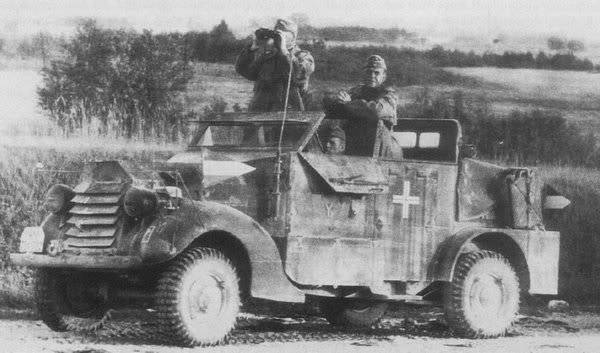
About these armored cars is written in sufficient detail in this article.
https://topwar.ru/37462-yuzhnoafrikanskie-broneavtomobili-marmon-herrington.html
Here we are with you and got to the very pulp. Before tanchiki. With good production facilities and heavy machinery, it was only reasonable for Marmon-Herington to try out himself on the tank path. Moreover, the army and foreign customers had a certain interest. The first attempts were made in the middle of 30's. Products focused primarily on export.
Combat Tank Light. The first sample built in 1935 year. The car turned out to be primitive and small. The armored box with the armored shell and the machine gun sticking out in the frontal sheet. By European standards - wedge, by American - barbet tank. Bulletproof armor, 110 hp engine, 2 crew of a man and nothing particularly outstanding. Angloviki writes that they were developed for Poland, but the Poles turned on the wedge. Also found information that several units bought Persia, which is Iran. The basis for the design, most likely, served as a tracked tractor.
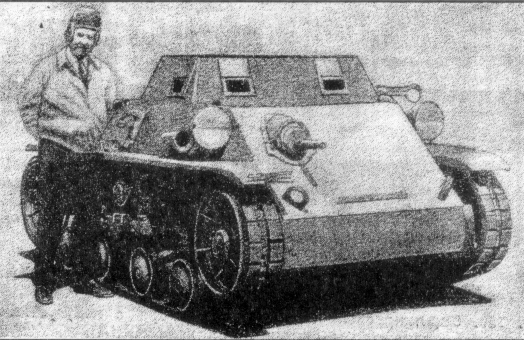
Well, since I managed to sell the first-born, then further research began. The second model was distinguished by a somewhat enhanced reservation and support rollers, the essence remained the same and the case did not get further than the prototype.
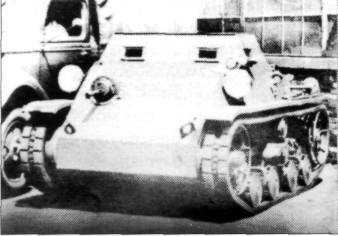
Perhaps the first combat vehicle developed and created by an American company for an individual order from another country. The fact is that the Mexican government in 1937 was interested in CTL-1,2 in the year and even wanted a couple of them, but modified. And it turned out something completely new. The tanket repeated the CTL only with a sooo shortened body, but the booking increased from 6 to 12 mm. The tank later received the title of the shortest combat vehicle in the world (length - 1,83м; width - 1,9м; height - 1,6м). Armament consisted of 2-x machine guns 7,62 in the front leaf. Whether 4, or 5 machines were manufactured and handed over to the customer, where they were in service with the 1942, after which they were replaced with the M5.
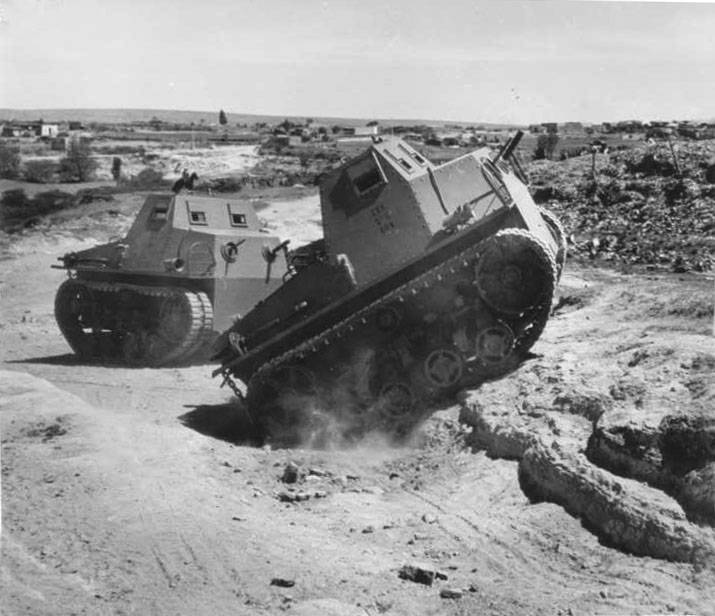
On maneuvers
Suddenly. The newly formed US Marine Corps turned its attention to Marmont tanks. The scarcity of equipment of the amphibious assault, especially in terms of the means of delivery to the coast, forced us to search for armor easier. From what was available to the 1935 year, everything was hard, but the CTL could be put in weight to the 3 tons by weight. Well, the work began to boil. Initially, the army TZ included a gun, and protection from large-caliber machine guns, and so that all up to three tons of weight. After numerous debates, the military thought better of it, and the result was CTL-3. Almost the same as the second model, only the weaponry increased by one 12,7 mm machine gun (for a total of two tank crews, three machine guns). By the beginning of 1937, all five machines ordered were manufactured and delivered.
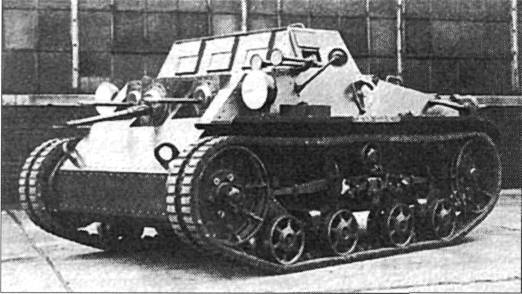
The results of the military operation, as well as the large landing exercises of the FLEX-4, revealed a number of shortcomings that the marmont tried to eliminate. The modified model has changed the index, got wider tracks, enhanced suspension and the engine Hercules horsepower 124 hp. The delivery to service of five more cars stretched right up to the middle of 1939. By this time, the means of delivery had improved significantly, and there was no such obvious need for heavy weight restrictions.
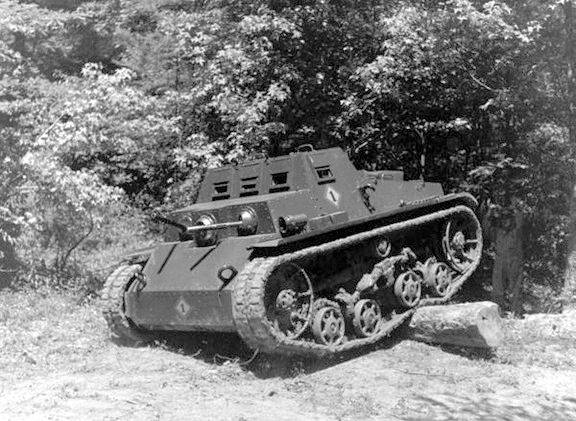
At the beginning of 1940, the 1-I tank company of marines consisting of 5 CTL-3 and 5 CTL-3A, as well as one copy М2А4, borrowed for comparison, took part in the FLEX-6 exercises. According to the results М2А4 rejected because of unstable to sea water running, and from Marmon limited only suitable recognized CTL-3A. Marmon-Herrington commissioned the development of two machines at once, one easy up to 5,7. by type of predecessors, and the middle tower with three crew members and a mass of 8,2. Already existing tanks were brought to a single standard - CTL-3M, replacing the spring in the chassis with springs, as well as replacing the heavy machine gun with 7,62.
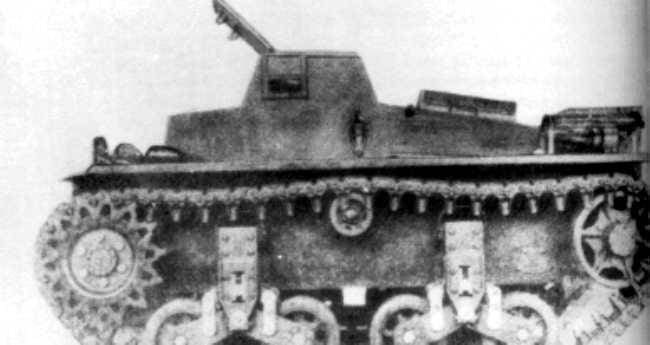
The last barbet tank company. Again, just a modified predecessor. The armor thickened to 11 mm (except for the engine hatch), the engine changed, and the track rollers were unified with the M2A4. And so, all the same 3 machine gun on the 2 crew. The marines, in turn, were desperate to see a normal tank from the Marmonas, gradually turning off cooperation and ordered only 20 machines, which began to arrive in parts from May 41. There was already a war on the street, but CTL-6 was lucky, and they fought on the Pacific Islands before 43, without fights and losses, after which they were safely replaced with M3.
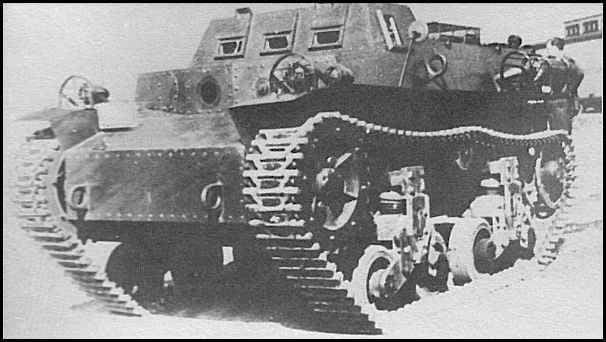
Well, since it is no good without a tower, then not to throw out a completely suitable chassis. Remember, they entrusted the development of a light tank to 5,7 tons for the Marmonas, and so they took their wedges and stuck the tower on top, well, they played around with the dimensions of a little. The suspension was already like the 3M with vertical springs instead of springs. The marines engine wanted a diesel, because the unification and all the cases, well, they put Hercules DXRB on 124 horses. Armament is generally a paragraph. In addition to the three 7,62 machine guns in the frontal list, another 2 Browning 12,7mm was installed in the tower. And all that stuff on the 3 man crew. Well, such a decision, frankly thoughtless. Well, got what they fought for. The army team continued to cheerfully continue to purchase the M2 and the M3, and CTL-3TBD produced an experimental number of 5 copies. All five left for Samoa, where the war ended for them in 1943.
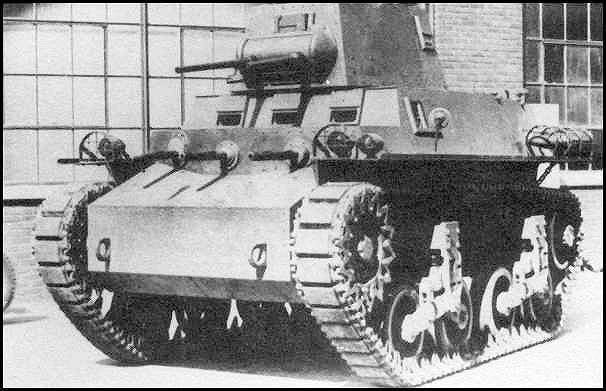
Suddenly, in our tank epic, Holland appears in the face of the Dutch East Indies. And it was like that. Closer to 40, the government of Holland ordered a lot of Vickers Model 1936 from the UK, but because of the British entering the war, the supply failed, customers were stabbed. The British used the machines as training ones, mockingly calling them "Dutch".
There are no tanks, I want tanks, so we must look for them. All the war, all government orders and only Marmon Herrington lonely waving his CTL. For beskronke and tank - tank. The CTL-6 was taken as a basis, reinforcing the booking to 25 mm (not everywhere), only the customer wanted with a machine gun turret, and not just with a turret, but with an offset, and on the part of the machines the turret was shifted to the right, and to the second - to the left. Accordingly, the controls changed places. Indian ... or Indian cunning was that the tower did not provide circular fire and planned to use a pair of tanks. Just imagine this ballet. The left-headed vehicle is CTLS-4TAC, the right-headed vehicle is CTLS-4TAY. I don’t know, the reason is not constructive, because the CTL-3TBD tower stood boldly in the center ... There were interesting times.
So, the order flew as much as 234 units and the Marmonas sat down a bit, because they had never done so much. But money is everything and work has begun to boil. It was planned to close the delivery by the end of 41, but only 20 (or 24) machines reached the colony. And here they are the first of the firm’s tanks that have fought, albeit unsuccessfully. During the capitulation of the Ost-India, the 50 of the brand-new CTLS-4 just went there, so that they should not be lost to Australia, where they were used as training (there is a version that the Japanese submarine sank along with the ship). 28 also went to Dutch Guiana, where they served without incident.
The remaining cars were confiscated by the US government and also sent to training units. Evaluating the tanks as quite suitable for combat service, they also ordered 240 units that they wanted to transfer to Kuomintang China, but he refused such dashing armored vehicles and all 240 remained at home to protect the Aleutian Islands and Alaska. In service with the US, the tanks were re-indexed as T14 / T16, left-hand drive, right-hand drive, respectively.
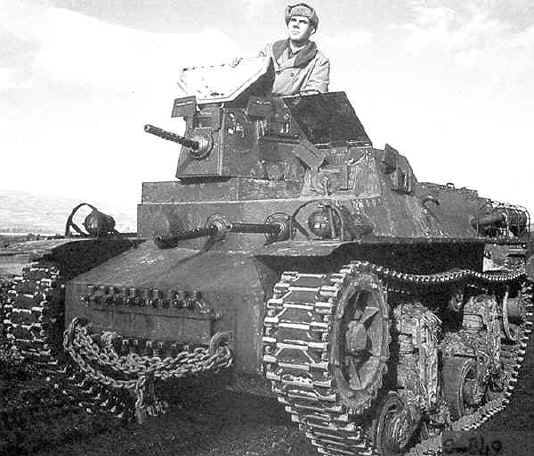
HAND
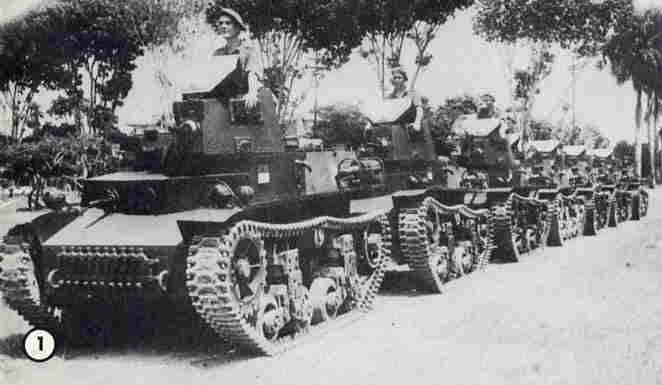
TAC
While the tragic events for Holland have not yet happened, they turned to Marmon-Herrington not only for light, but also for medium tanks. The one who pays is the one who orders the music, the Americans decided and got down to business. Taking CTL-3TBD as a basis (this is the first one with the turret), they went according to the old scheme: enhanced booking, new engine (174 hp) and gearbox, and installed a quick-fire 37 mm gun and twin machine gun in the turret. Only the 2 machine gun left in the frontal list. Again an ambitious order was made for the 194 tank. To the customer arrived either 28, or 31 unit. About participation in the fighting nothing is known. About 30 manufactured, but not sent to the surrender of the East Indies, the machines were requisitioned by the US government and later sold to Cuba, Ecuador, Guatemala and Mexico. Individual TBDs served until the 50s.
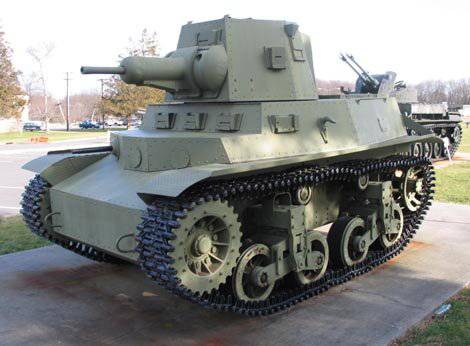
Wow, how they like ponavorachivat beech and tsifer in the index. Hot on the heels they took their predecessor, installed an 240 horsepower engine, increased their frontal booking to 25 mm, and further increased the turret and put the twin 37mm guns and machine gun there. The crew also grew to 4 tank crews, the weight also grew to 20 tons. And they welded the 2 bracket for anti-aircraft machine guns. The maximum number of 7,62 - 8 pieces, but in practice no more 4-x. The Dutch liked it again, and they said again: "Give me two hundred." In reality, only 20 arrived. The design, despite the formidable appearance, was not viable, the expected increase in practical rate of fire did not occur. It would be much more reasonable to install one, but more powerful artillery system.
This is perhaps the most successful and high-quality car company. Once again I will not repeat, there is a quite decent article about Locusts already.
https://topwar.ru/95042-legkiy-aerotransportabelnyy-tank-m22-locust.html
The only thing to note is that the T22 marking is American, and Locust is British, it is somewhat incorrect to use them in pairs.
And what can I say? Good company, good technique. They didn’t have a good deal with the tanks, but here you can see that when the company itself, with its mind trying to do something good, does not always work. Only the M22 turned out to be successful and the result of the work of civil engineers in tight pairing with military experts. And the same MTLS or CTLS-4 could well turn into something worthwhile, pass through thoughtful state tests with careful work on the errors. But this is all history now, the history of American tanks, such an original fascinating and damnably complex.
Sources used:
https://en.wikipedia.org/
http://www.maxinkuckee.history.pasttracker.com/lots_1100_e_shore/nordyke_marmon_company.htm
http://theoldmotor.com/?p=152762
http://www.american-automobiles.com/Marmon-1902-1908.html
http://auto.howstuffworks.com/marmon-cars.htm
http://www.offroadvehicle.ru/
http://www.dws-xip.pl/encyklopedia/cvth310-ir/
http://www.aviarmor.net
http://www.redov.ru/tehnicheskie_nauki/yenciklopedija_voennyh_avtomobilei_1769_2006_gg_k_r/p109.php
http://strangernn.livejournal.com/589377.html
http://cars-repaer.ru/stati/neus107.html
http://strangernn.livejournal.com/
http://warspot.ru/5045-stalnaya-sarancha
http://alternathistory.com/andrei-kharuk-amerikanskie-raritety-tanki-firmy-marmon-herrington
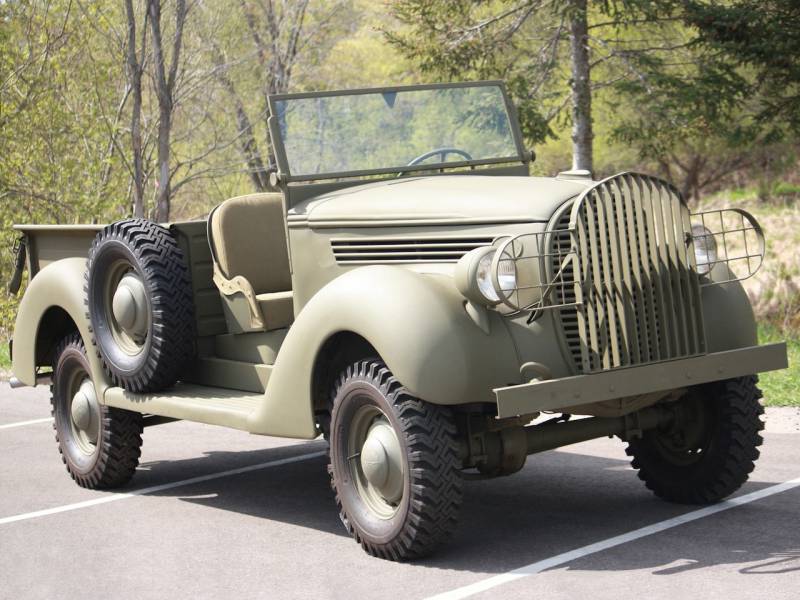
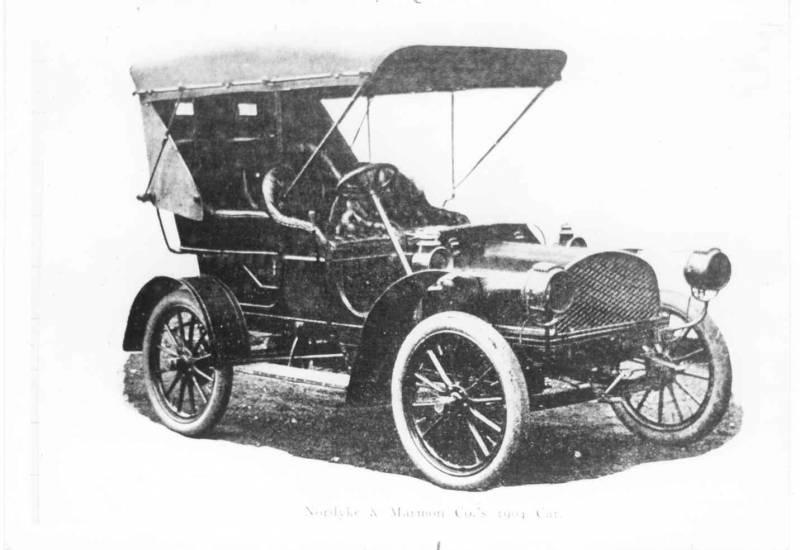
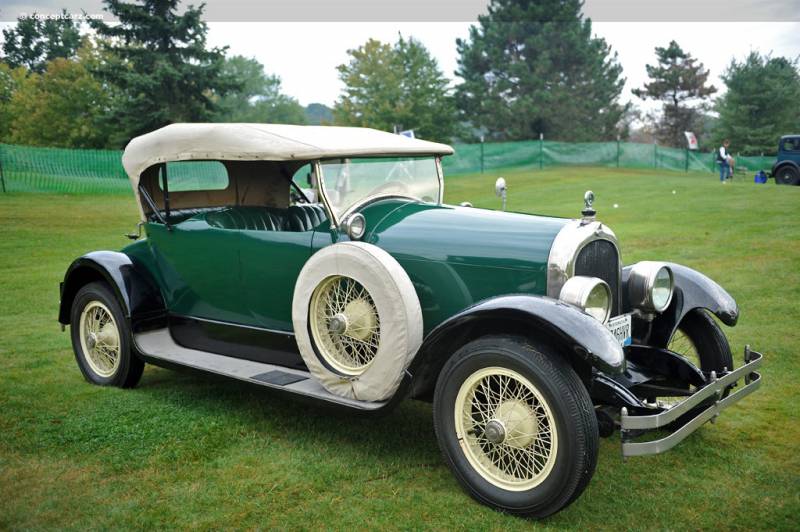
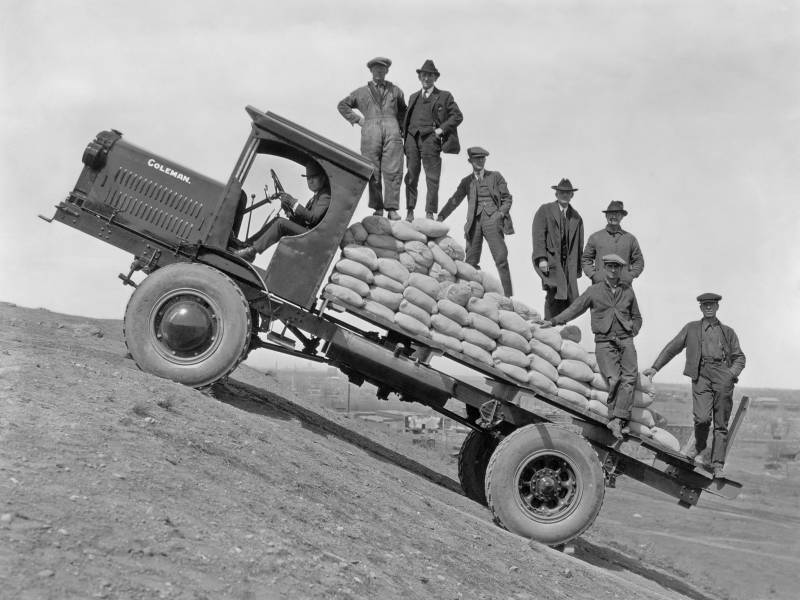
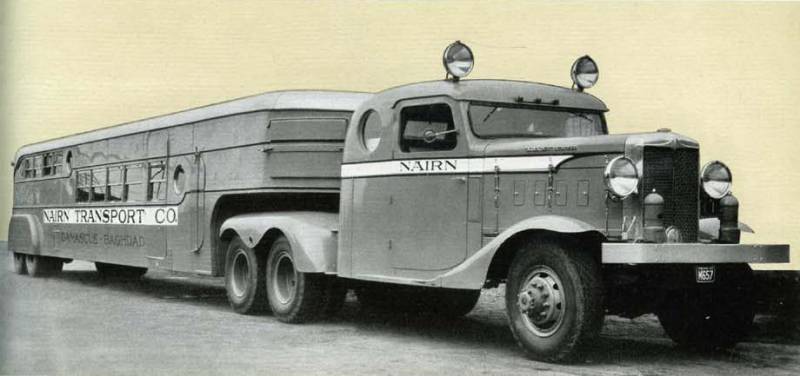
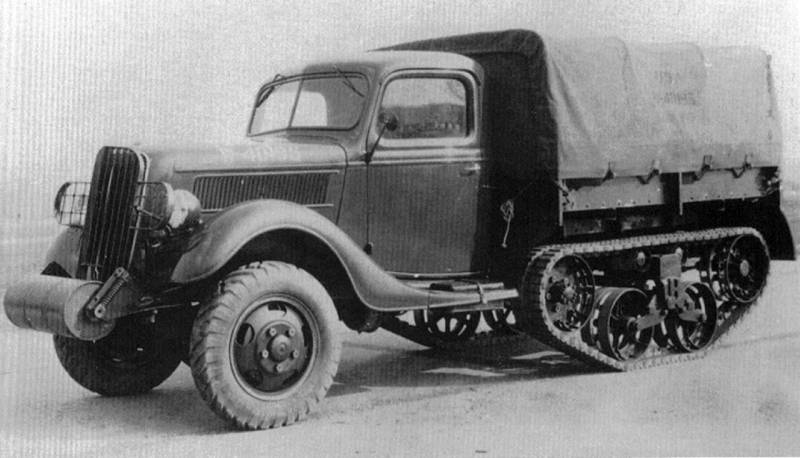
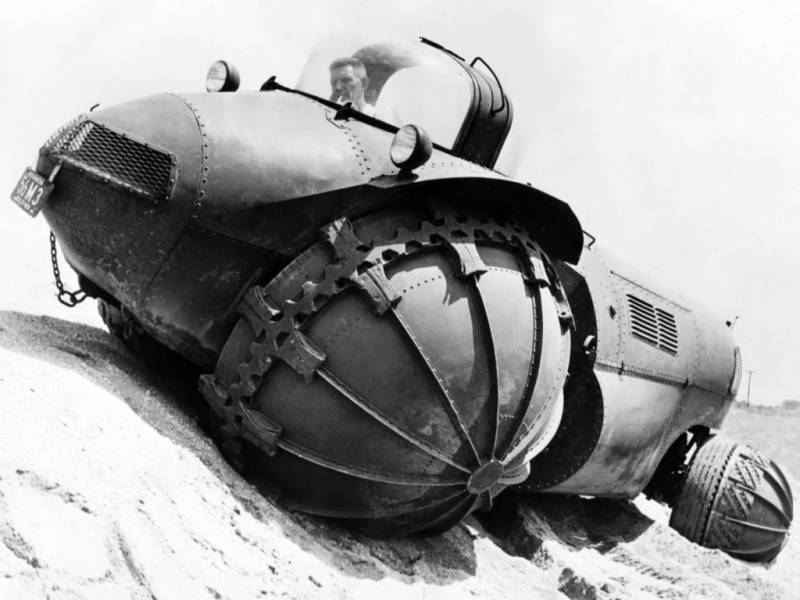
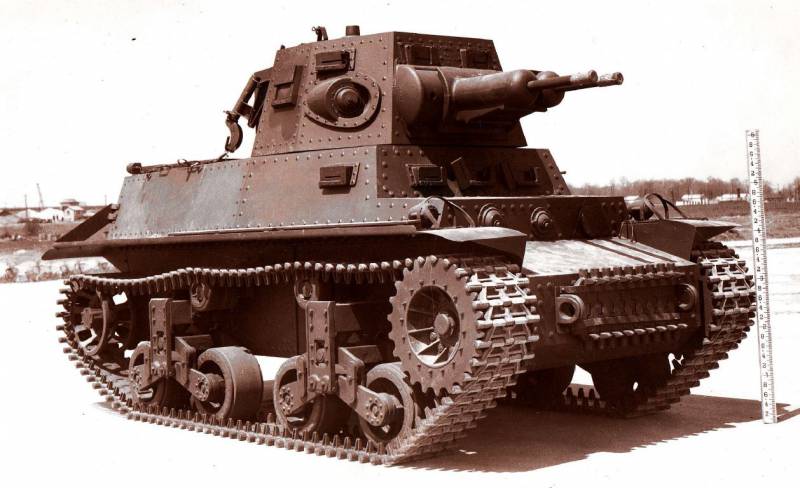
Information